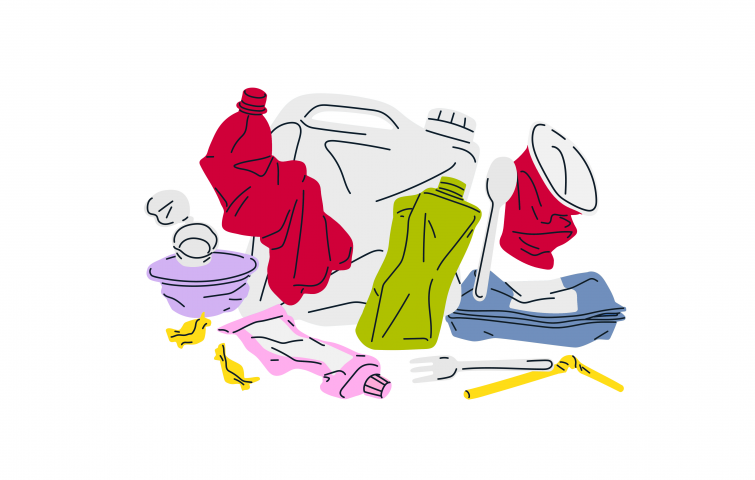
November 22, 2024
Bulletin interne de l'Institut Pasteur


Waste: at the Institut Pasteur, nothing is lost, everything is transformed
This year's European Week for Waste Reduction runs from November 16 to 24. This is an opportunity to highlight the Institut Pasteur's efforts to recycle all the waste that it possibly can. It goes far above and beyond the minimum required by law, even recycling some pens and laboratory equipment.
Under French law, companies are required to dispose separately of paper/cardboard, metal, plastic, glass packaging, organic waste from restaurants, waste electrical and electronic equipment (WEEE) and wood so that it can be recycled at accredited recycling centers. But the Institut Pasteur wanted to go further and deliberately chose to implement a more far-reaching strategy. "In the space of ten years, we have introduced recycling for many other products, including batteries, used ink and toner cartridges, polystyrene and pens and markers," explains Abokouo Zago, Head of the Institut Pasteur's Waste Management and Recycling Department (GVED), who has been with the Institut Pasteur for 17 years. "We have signed agreements with producer responsibility organizations to ensure each of these materials is reused or recycled. We also recover clean cardboard packaging for reuse on campus, for example for collecting confidential papers."
Institut Pasteur staff increasingly committed to recycling
It goes without saying that introducing recycling for so many types of waste has a cost and requires staff. Around 30 employees in the department are already involved in these efforts. But to ensure that the system does not weight too heavily on the Institut Pasteur budget, we encourage staff to take their waste to the voluntary collection points (a map showing the location of these collection points can be found in the Guide to recycling and recovery for recyclable materials collected). "It requires an effort," acknowledges Abokouo Zago. "But we are seeing that Institut Pasteur staff are increasingly aware of the environmental cost of waste production and so they are willing to get involved".
"We are also working to introduce recycling for non-hazardous waste from research activities. Having worked in a laboratory myself for ten years as a biological engineer, I am familiar with the types of waste generated during lab work: tip boxes, 96-well plates, WEEE (centrifuges, incubators, etc.) and more," adds Abokouo Zago.
Some types of waste produced during break times should soon also have their own streams: dirty biodegradable cups, coffee pods and cigarette butts. The aim is to reduce the volume of household and similar waste as much as possible. Although incinerating household waste contributes to the urban heating network and produces electricity, it is better to reuse or recycle where possible to reduce pressure on natural resources.
Organic waste recovered and pens turned into tables
The GVED Department is responsible for the traceability of each waste stream and for monitoring any regulatory changes. It keeps up to date with new innovations that might help optimize waste management. For example, when the Institut Pasteur introduced a separate waste stream for organic food waste collected for anaerobic digestion, it invested in waste dryers to extract moisture, thereby reducing the volume by 80% and lessening the storage space needed. This also cut the number of trips made by waste collection trucks, keeping noise down for local residents and reducing our carbon footprint. Outlets were also found for polystyrene, which can be used to produce insulating materials, and for pens and markers – as seen in the picnic table outside the "Le Bienfait" cafeteria, which was made from used pens.
In 2019, a Reuse room has been launched, where employees can drop off and pick up office and laboratory supplies in good condition that have been provided by other teams. After all, the best way to manage waste is not to produce it in the first place.
Find out more (Webcampus)
What do we mean by "non-hazardous" waste?
Non-hazardous waste is any waste that does not have dangerous properties. At the Institut Pasteur, 1,013 tons were collected and sent to recovery plants in 2023:
• 734 t. of household waste
• 147 t. of waste from construction dumpsters
• 110 t . of paper and cardboard
• 13 t. of waste electrical and electronic equipment (WEEE)
• 13 t. of polypropylene (tip boxes)
• 4.05 t. of glass packaging
• 2.7 t. of dried organic waste (13.5 t. before drying)
• 1 t. of plastic bottles
• 0.5 t. of aluminum (cans)
• 0.214 t of batteries
• 0.548 t. of used ink and toner cartridges
• 0.407 t. of light bulbs (fluorescent tubes, LED bulbs, etc.)
• 0.04 t. of pens, markers, highlighters and corrector pens
From left to right : Melvyn Leyrat, François Quelier, Abokouo Zago, Issam Krai
